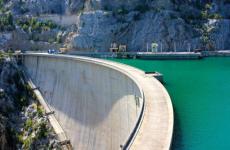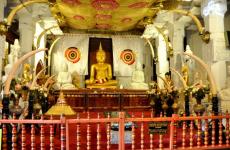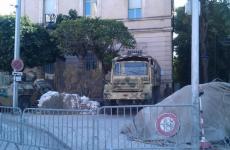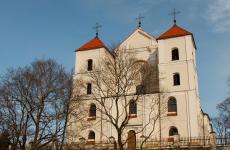3 major cities. The largest cities in Russia
Every year the population of large cities, and, therefore, their territory continues to increase steadily. Therefore, cities can be compared not only by population, but also by the area they occupy.
1. Moscow (2561.5 sq. km)
Moscow is gradually expanding and increasing its area. In 2012, there was a sudden increase in the size of the capital, when it was decided to annex a significant piece of the territory of the Moscow region. Thus, the area of the metropolis now consists of 780 square meters. km located within the Moscow Ring Road (which was traditionally considered Moscow), and the remaining share is the territory of the region located outside the Moscow Ring Road in the south-west direction.
More people live in Moscow than in some large European countries (for example, Norway and Finland taken together, about the same number live in Belgium and the Czech Republic). And this is only according to official statistics. In a giant “anthill” there are native Muscovites, people coming for a better life from the Russian hinterland, labor migrants from neighboring countries, and students. Moscow's population growth is driven not by birth rates, but by influx from outside. The main goal of visitors is to earn money.
2. St. Petersburg (1439 sq. km)

This city is the most important economic, cultural and scientific center of the country after Moscow; it is also a major transport hub. The historical center of the city and the historical and architectural monuments located in it and in the suburbs are under UNESCO protection. Therefore, St. Petersburg is one of the most important tourist routes in Russia. In 2015, the city's population exceeded the 5 million mark. In terms of population in Europe, it is second only to Istanbul, Moscow and London. Among the northern cities of the world, it is the largest, as well as the first in Europe among cities that are not capitals. St. Petersburg has the status of a city of federal significance. The population of Leningrad in the 1980s also reached 5 million, but in the crisis years of the 90s there was a depopulation phenomenon - when the mortality rate began to exceed the birth rate, as a result of which the city's population decreased significantly. And only in 2012 it again reached the same 5 million mark, and by 2019 it amounted to almost 5.4 million people.
Russia is unique in that, thanks to its vast territory, it finds itself in four climatic zones at once. It is clear that in different parts of it the climate...
3. Volgograd (859.4 sq. km)

Volgograd is a hero city, originally called Tsaritsyn, then Stalingrad for some time. Now it has more than a million inhabitants. The city stands on the Volga, along which ancient trade routes passed. This city forever linked its name with the largest battle of World War II, the Battle of Stalingrad, in which the heroism, courage and unbending will of our soldiers were demonstrated. To perpetuate the memory of this battle, the majestic Motherland monument was erected in Volgograd, which has since become the hallmark of the city.
4. Perm (8.7 sq. km)

Perm is another Russian city with a million population. It is a major industrial and transport center of the country. Peter I ordered the construction of a city in a place in the Siberian province where copper could be mined, and the specific location was chosen by V. Tatishchev. The year of foundation of Perm is considered to be 1723. The first Ural railway was laid through Perm in 1876. In 1940 it was renamed Molotov, but in 1957 the historical name was returned. Before the formation of the city, people had settled in this place since ancient times; over 130 archaeological sites were discovered within the city, which date back to the late Middle Ages and even the Stone Age.
5. Ufa (707.9 sq. km)

More than 1.2 million people live in modern Ufa, the capital of the Republic of Bashkortostan. If we take into account the population density, the residents of Ufa live much more freely than other city residents - for each Ufa resident there are more than 600 square meters. m. city. This city is a large economic, scientific, cultural and sports Russian center. The importance of Ufa was emphasized by the meetings of the leaders of the SCO and BRICS held here in 2015. A large share of the city's territory is occupied by green spaces, squares and parks. There are many different monuments in the city.
6. Tyumen (698 sq. km)

The first Russian city founded in Siberia was Tyumen, which happened in the 16th century. The city owes its appearance to the construction of the Tyumen fort, which was ordered to be built by the third son of Ivan IV, Fyodor Ivanovich. The population of Tyumen is now 788.7 thousand people, it is divided into 4 administrative districts. Until 2014, the urban district included and was subordinate to the city 19 more surrounding villages, but after that they lost their status as independent settlements. The share of urban development from the entire territory of Tyumen accounts for just over 160 sq. km, that is, only 23% of the area of the urban district. Near the city there are at least five geothermal springs with water temperatures from 37 to 50 degrees; they have good balneological properties. Quality of life studies conducted annually in Russian cities have put Tyumen in first place for several years now.
It is noteworthy that during World War II, Lenin’s body was sent from the mausoleum in Moscow to Tyumen.
7. Ulyanovsk (622.46 sq. km)
.jpg)
Ulyanovsk was founded as a frontier to protect the Russian kingdom from raids by nomads from the east in 1648. Today it is the administrative center of the Ulyanovsk region, located on the banks of two rivers, Sviyaga and Volga. Since 2015, Ulyanovsk has become a UNESCO city of literature.
The city has a developed automotive, motor, aircraft and instrument manufacturing industry and is home to 626.5 thousand people.
8. Orsk (621.3 sq. km)

Orsk is divided into three administrative districts, and its population is only 234.4 thousand people. The city is located in picturesque places - on the spurs of the Ural Mountains. Along the bed of the Ural River flowing through Orsk there is a division into Europe and Asia. It is mainly an industrial city, the second most important in the Orenburg region. It operates in such industries as mechanical engineering, non-ferrous metallurgy, mining, petrochemicals, light and food industries. There are about 4 dozen archaeological sites in Orsk. The local variegated jasper is especially famous, the deposit of which is located right within the city, on Mount Colonel. Orsk jasper has the widest variety of colors and patterns.
According to a sociological survey, Muscovites perceive their city as a place where they can realize their spiritual, financial, business and cultural...
9. Kazan (614.2 sq. km)

Unofficially, the capital of the Republic of Tatarstan, Kazan, is called the third Russian capital. This ancient city is more than 1000 years old. It is multinational, 115 nationalities coexist peacefully in Kazan, but the backbone is made up of Russians (48.6%) and Tatars (47.6%). Kazan is a significant cultural, economic, scientific and religious center of Russia, as well as a large river port. Sports in Kazan are also developing very rapidly. The city authorities attach great importance to the development of tourism and encourage the holding of various festivals. The main architectural attraction here is the Kazan Kremlin, which is under UNESCO protection.
9. Voronezh (596.5 sq. km)

In 2010, the Voronezh urban district included over 20 suburban small settlements, which significantly increased the birth rate. As a result, in 2012 the city's population exceeded the million mark and continues to gradually grow. From the west, the Don River flows through the city, and to the east the Voronezh River, turned into a reservoir. This proximity allowed Voronezh to become a major river transport hub. Although Voronezh has preserved many wonderful architectural monuments, it does not lag behind in modern creativity: there are sculptures of White Bim from the famous feature film and a charming kitten from the Soviet cartoon. A monument to Peter I was also erected in Voronezh.
10. Omsk (566.9 sq. km)

During the Civil War in the 20s of the last century, Omsk was proclaimed the capital of the Russian State, since Admiral Kolchak’s Headquarters and the center of the White movement were located here. Now Omsk is one of the largest Russian cities, and recently it has again become the capital - this time of the Siberian Cossack Army. It is the second most populous city in Siberia (1.17 million inhabitants). Many architectural monuments have been preserved in Omsk, the most significant of which are the Omsk Fortress included in the UNESCO cultural heritage list and the Assumption Cathedral, which is included in the catalog of examples of world temple architecture.
In Russia today there are about a thousand cities. All of them differ radically in area and number of residents.
The smallest city is Chekalin. It is located in the Suvorovsky district of the Tula region and has been known only since the end of the 19th century, but is, nevertheless, one of the historical cities of Russia. It is interesting that before the revolution in the city of Likhvin, Kaluga province (that is what the city was called until 1944, which received its name in honor of the partisan Alexander Chekalin) there were about 1,700 people.

According to the 2010 census, the city has a population of only 994 people. Despite such a number of indigenous inhabitants, the settlement still retains the name city. The status of the city was preserved due to the fact that during reporting activities on the liquidation of small towns, a sheet with cities that began with the letters Ch, Sh and Sh was lost.
The largest city in Russia by population
Moscow
Population - more than 15 million people.Naturally, in terms of population, the largest city in our country is the capital. This metropolis is home to many more people than in a number of European countries, for example, than in Finland and Norway combined. And approximately the same number of inhabitants are located in the Czech Republic and Belgium. And this is only according to official data.

More than 15 million people live in Moscow. This quantity, by the way, is typical for such a small country as Kazakhstan. According to experts, only about 10 million people have a capital residence permit, and another million live with temporary registration. The rest are registered foreigners, visitors (migrant workers, guest workers, students) and illegal immigrants. There is a constant influx of population to Moscow, mainly residents of other regions come to the capital - Russians, and residents of other countries, come here in search of work. It is worth noting that more than 90 percent of the population of Moscow are Russians.
Saint Petersburg
Population - more than 5 million people.The Northern capital accommodated three times fewer people than in the capital. The cultural center of the country is inhabited by approximately 5 million people. The five millionth resident of St. Petersburg was born in September 2012. In addition, St. Petersburg is the fourth largest city in Europe. By the way, in the northern capital there are more Russians in percentage terms than in Moscow.

The number of people living in other cities of Russia, which can be called large, ranges from 1-1.5 million people.
Novosibirsk
Population - more than 1.5 million people.The city is quite young. It appeared just over a hundred years ago. The number of people living in the largest city in Siberia has already exceeded 1.5 million people. By the way, Novosibirsk is one of the few world record holders for turning a small town into a millionaire city. And in the 21st century, it became the first Russian city (of course, after two historical capitals) in which the population exceeded one and a half million. Despite the distance from the capital, the city of Novonikolaevsk, as Novosibirsk was formerly called, is home to more than 80 representatives of different nationalities. These include Germans, Tatars, Kazakhs, Finns, Koreans and Poles.

Ekaterinburg
Population - about 1.4 million people.Yekaterinburg has every chance of displacing its predecessor from the pedestal. As of 2012, the capital of the Urals is home to almost 1.4 million people. The top five largest cities in Russia are completed by Nizhny Novgorod with a population of about 1.3 million people.

It is worth noting that Chelyabinsk, Omsk, Rostov-on-Don, Ufa, Volgograd, Samara and Kazan are among the million-plus cities. More recently, Perm was in the ranking, however, the city has lost the honorary title of million-plus population. Its place was empty for a relatively short time; Krasnoyarsk became a city with a population of one million.
The largest cities in Russia by area
Sochi
Area - 3605 square kilometers.Sochi is also a record holder among cities in another “nomination”. It is the longest city in Russia. The capital of the 2014 Winter Olympics and the 2018 FIFA World Cup matches stretches along the Black Sea coast for 145 kilometers, and the lion's share of the distance, namely 118 kilometers, is the beach strip. The resort capital is divided into Central, Khostinsky, Lazarevsky and Adler districts.
The largest settlements in the Russian Federation are traditionally selected according to two criteria: occupied territory and population. The area is determined by the general plan of the city. Population – the All-Russian Population Census, or Rosstat data, taking into account birth and death rates, if they are current.
The largest cities in Russia by population
There are 15 largest cities in Russia with a population of more than 1 million people. According to this indicator, Russia ranks third in the world. And their number continues to grow. More recently, Krasnoyarsk and Voronezh entered this category. We present to you the top ten most densely populated Russian megacities.
Population: 1,125 thousand people.
Rostov-on-Don became a million-plus city relatively recently - only thirty years ago. It is the only one among the ten largest cities in Russia that does not have its own metro. Its construction in 2018 will only be discussed. For now, the Rostov administration is busy preparing for the upcoming World Cup.
Population: 1,170 thousand people.
 In penultimate place in the list of the largest cities in Russia by population is the administrative center of the Volga region - Samara. True, starting from 1985, the population preferred to leave Samara as soon as possible, until by 2005 the situation improved. And now the city is even experiencing a slight increase in migration.
In penultimate place in the list of the largest cities in Russia by population is the administrative center of the Volga region - Samara. True, starting from 1985, the population preferred to leave Samara as soon as possible, until by 2005 the situation improved. And now the city is even experiencing a slight increase in migration.
Population: 1,178 thousand people.
 The migration situation in Omsk is not brilliant - many educated Omsk residents prefer to move to Moscow, St. Petersburg and neighboring Novosibirsk and Tyumen. However, since 2010, the population in the city has been growing steadily, mostly due to the redistribution of the population in the region.
The migration situation in Omsk is not brilliant - many educated Omsk residents prefer to move to Moscow, St. Petersburg and neighboring Novosibirsk and Tyumen. However, since 2010, the population in the city has been growing steadily, mostly due to the redistribution of the population in the region.
Population: 1,199 thousand people.
 Unfortunately, Chelyabinsk is experiencing problems with livability: residents complain about the abundance of dirt, giant puddles in the spring and summer, when, due to non-functioning storm sewers, entire neighborhoods turn into something like Venice. It is not surprising that about 70% of Chelyabinsk residents are thinking about changing their place of residence.
Unfortunately, Chelyabinsk is experiencing problems with livability: residents complain about the abundance of dirt, giant puddles in the spring and summer, when, due to non-functioning storm sewers, entire neighborhoods turn into something like Venice. It is not surprising that about 70% of Chelyabinsk residents are thinking about changing their place of residence.
Population: 1,232 thousand people.
 The capital of the Republic of Tatarstan rightfully bears the title of one of the most comfortable cities in Russia. This is likely one of the reasons why the city has experienced steady population growth since the mid-90s. And since 2009, Kazan has become a plus not only due to migration, but also due to natural growth.
The capital of the Republic of Tatarstan rightfully bears the title of one of the most comfortable cities in Russia. This is likely one of the reasons why the city has experienced steady population growth since the mid-90s. And since 2009, Kazan has become a plus not only due to migration, but also due to natural growth.
Population: 1,262 thousand people.
 The ancient and very beautiful city is going through hard times in terms of the number of residents. The peak was in 1991, when its population exceeded 1,445 thousand people, and since then it has only been falling. A slight increase was observed only in 2012–2015, when the population increased by approximately 10 thousand people.
The ancient and very beautiful city is going through hard times in terms of the number of residents. The peak was in 1991, when its population exceeded 1,445 thousand people, and since then it has only been falling. A slight increase was observed only in 2012–2015, when the population increased by approximately 10 thousand people.
Population: 1,456 thousand people.
 The “Capital of the Urals” became a million-plus city exactly 50 years ago, in 1967. Since then, having survived the population decline in the “hungry 90s,” the city’s population has been growing slowly but steadily. It is increasing, as in all large cities of Russia, mainly due to migrants. But not the ones you thought about - the population replenishment mainly (more than 50%) comes from the Sverdlovsk region.
The “Capital of the Urals” became a million-plus city exactly 50 years ago, in 1967. Since then, having survived the population decline in the “hungry 90s,” the city’s population has been growing slowly but steadily. It is increasing, as in all large cities of Russia, mainly due to migrants. But not the ones you thought about - the population replenishment mainly (more than 50%) comes from the Sverdlovsk region.
Population: 1,602 thousand people.
 The third place in the list of the largest cities in Russia is occupied by the center of the Novosibirsk region. In addition to its million-plus status, the city can also boast of being among the top 50 cities in the world with the longest traffic jams. True, Novosibirsk residents are hardly happy about such a record.
The third place in the list of the largest cities in Russia is occupied by the center of the Novosibirsk region. In addition to its million-plus status, the city can also boast of being among the top 50 cities in the world with the longest traffic jams. True, Novosibirsk residents are hardly happy about such a record.
However, unlike traffic jams, the demographic situation in the city is more or less successful. A number of regional and state programs aimed at increasing the birth rate and reducing mortality are being implemented in Novosibirsk. For example, at the birth of a third or subsequent child, the family is awarded a regional certificate for 100 thousand rubles.
According to city authorities, if the current dynamics of population growth continue, then by 2025 the number of residents of the Novosibirsk region will increase to 2.9 million people.
Population: 5,282 thousand people.
 The cultural capital of Russia, where polite intellectuals bow to each other, raising their berets, and where such animals as the “bun” and “curb” live, is demonstrating steady growth in both area and population.
The cultural capital of Russia, where polite intellectuals bow to each other, raising their berets, and where such animals as the “bun” and “curb” live, is demonstrating steady growth in both area and population.
True, this was not always the case; Since the end of the USSR, the population preferred to leave St. Petersburg. And only since 2012, positive dynamics began to be observed. In the same year, the city's five millionth resident was born (for the second time in its history).
1. Moscow
Population: 12,381 thousand people.
 It is unlikely that the answer to the question: “What is the largest city in Russia?” came as a surprise to someone. Moscow is the largest city in Europe by population, but is not among the first.
It is unlikely that the answer to the question: “What is the largest city in Russia?” came as a surprise to someone. Moscow is the largest city in Europe by population, but is not among the first.
More than 12 million people live here, and if we add to this the population of the near Moscow region, who regularly travel to Moscow for work and shopping, then the figure turns out to be more than impressive - 16 million. Due to the current economic situation in the country, the population is both modern Babylon and the surrounding areas will only increase. According to expert forecasts, by 2030 this number could reach 13.6 million people.
Muscovites are traditionally not happy with those who have come in large numbers, and those who have come in large numbers shrug their shoulders: “I want to live, and I even want to live well.”
The largest cities in Russia by area
It would seem that the list of the largest cities in Russia by area should coincide with the list of the most populated cities, but this is not the case. In addition to the simple population size, the area of the city is influenced by many factors - from the historical method of territorial expansion to the number of industrial enterprises within the city. Therefore, some positions in the ranking can surprise the reader.
Area: 541.4 km²
 Samara opens the top 10 largest cities in Russia. It stretches along the western bank of the Volga River for more than 50 km with a width of 20 km.
Samara opens the top 10 largest cities in Russia. It stretches along the western bank of the Volga River for more than 50 km with a width of 20 km.
Area: 566.9 km²
 The population of Omsk exceeded a million people back in 1979, the city’s territory is large and, according to Soviet tradition, the city should have acquired a metro. However, the nineties struck, and construction since then has been going neither shaky nor slow, but in general nothing. There is not even enough money for conservation.
The population of Omsk exceeded a million people back in 1979, the city’s territory is large and, according to Soviet tradition, the city should have acquired a metro. However, the nineties struck, and construction since then has been going neither shaky nor slow, but in general nothing. There is not even enough money for conservation.
Area: 596.51 km²
 Voronezh became a million-plus city quite recently - in 2013. Some areas in it are almost exclusively private sector - houses, from comfortable cottages to village ones, garages, vegetable gardens.
Voronezh became a million-plus city quite recently - in 2013. Some areas in it are almost exclusively private sector - houses, from comfortable cottages to village ones, garages, vegetable gardens.
Area: 614.16 km²
 Thanks to the historically established radial-ring development, Kazan is a fairly compact city with a convenient layout. Despite its size, the capital of Tatarstan is the only million-plus city in Russia that completely recycles its waste and has managed to maintain a more or less favorable environmental situation.
Thanks to the historically established radial-ring development, Kazan is a fairly compact city with a convenient layout. Despite its size, the capital of Tatarstan is the only million-plus city in Russia that completely recycles its waste and has managed to maintain a more or less favorable environmental situation.
Area: 621 km²
 The only regional city that is not an administrative center and a million-plus population, Orsk seems to have been included in this rating by mistake. Its population is only 230 thousand people, who occupy an area of 621 km2, with a very low density (only 370 people per km2). The reason for such a huge territory with a small number of inhabitants is the large number of industrial enterprises within the city.
The only regional city that is not an administrative center and a million-plus population, Orsk seems to have been included in this rating by mistake. Its population is only 230 thousand people, who occupy an area of 621 km2, with a very low density (only 370 people per km2). The reason for such a huge territory with a small number of inhabitants is the large number of industrial enterprises within the city.
Area: 707.93 km²
 Ufa residents have a spacious place to live - each person has 698 m2 of the total territory of the city. At the same time, Ufa has the lowest density of the street network among Russian megacities, which often manifests itself in huge multi-kilometer traffic jams.
Ufa residents have a spacious place to live - each person has 698 m2 of the total territory of the city. At the same time, Ufa has the lowest density of the street network among Russian megacities, which often manifests itself in huge multi-kilometer traffic jams.
Area: 799.68 km²
 Perm became a million-plus city in 1979, then in the nineties, due to a general decline in the population, it lost this status for more than 20 years. Only in 2012 was it possible to return it. Permians live freely (the population density is not too high, 1310 people per km2) and green - the total area of green spaces is more than a third of the citywide area.
Perm became a million-plus city in 1979, then in the nineties, due to a general decline in the population, it lost this status for more than 20 years. Only in 2012 was it possible to return it. Permians live freely (the population density is not too high, 1310 people per km2) and green - the total area of green spaces is more than a third of the citywide area.
Area: 859.4 km²
 Although Volgograd became a million-plus city relatively recently - in 1991, it has long been among the top three in terms of territory size. The reason is the historically uneven urban development, where apartment buildings, village houses with plots and empty steppe spaces alternate with each other.
Although Volgograd became a million-plus city relatively recently - in 1991, it has long been among the top three in terms of territory size. The reason is the historically uneven urban development, where apartment buildings, village houses with plots and empty steppe spaces alternate with each other.
Area: 1439 km²
 Unlike the compact radial-beam “old” Moscow, St. Petersburg is freely spread out at the mouth of the Neva. The length of the city is more than 90 km. One of the features of the city is the abundance of water spaces, occupying 7% of the entire territory.
Unlike the compact radial-beam “old” Moscow, St. Petersburg is freely spread out at the mouth of the Neva. The length of the city is more than 90 km. One of the features of the city is the abundance of water spaces, occupying 7% of the entire territory.
1. Moscow
Area: 2561.5 km²
And the absolute first place among the largest cities in Russia is given to Moscow. Its area is 1.5 times larger than the area of the second place in the ranking, St. Petersburg. True, until 2012, the territory of Moscow was not so impressive - only 1100 km2. It grew so significantly due to the annexation of the southwestern territories, the total area of which reaches 1480 km2.





